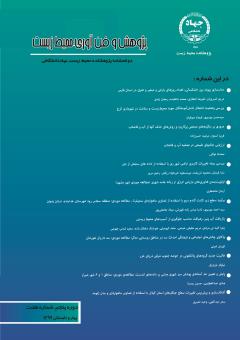برآورد سطح زیرکشت گندم دیم با استفاده از تصاویر ماهواره ای سنتينل2 (مطالعه موردی: منطقه سجاسرود شهرستان خدابنده استان زنجان)
محورهای موضوعی : سنجش از دور و جغرافیای زیستیسید احمد موسوی 1 , نادیا عباس زاده طهرانی 2 * , میلاد جانعلی پور 3
1 - سنجش از دور و سیستم اطلاعات جغرافیایی، واحد الکترونیکی دانشگاه آزاد اسلامی، تهران، ایران
2 - پژوهشگاه هوافضا وزارت علوم تحقیقات و فناوری
3 - پژوهشگاه هوافضا وزارت علوم تحقیقات و فناوری
کلید واژه: سطح زیر کشت, گندم, سنجشازدور, طبقهبندی, سنتينل 2,
چکیده مقاله :
كشت و توليد محصول گندم همواره پاسخگوي نيازهاي تغذيه اي بخش عظيمي از مردم جهان بوده است، لذا در ايران و جهان ازجمله محصولات کشاورزی استراتژيك محسوب میشود. در اختیار داشتن آمار و اطلاعات مناسب از سرزمين هاي تحت كشت گندم و برآورد ميزان دقيق توليد آنها در يك سال زراعي، به برنامه ريزان بخش كشاورزي و صنعت جهت مدیریت هرچه مؤثرتر تولید و مصرف محصول مذکور، كمك شاياني مي نمايد. یکی از ابزارهایی که در کمترین زمان و با هزینه پایین و دقت مناسب میتواند سطح زیر کشت گندم را محاسبه نماید علم و فناوری سنجشازدوراست. در تحقیق حاضر، با استفاده از کلاسهبندی نظارتشده تصاویر چند زمانه سنجنده سنتينل 2، سطح زیر کشت گندم و میزان تولید آن در دهستان سجاسرود از توابع شهرستان خدابنده استان زنجان برای سال زراعی 96-97 برآورده شده است. طبقهبندی نظارتشده با دقت کلی80% و ضریب کاپای 8/0 نتایج قابلقبول و مناسبی برای شناسایی و تفکیک گندم از سایر محصولات كشاورزي را ارائه مي دهد.
Wheat is one of the strategic agricultural products which provides one of the most basic nutritional needs of human societies for Iran and the whole world. Having the right statistics and information of the lands under wheat cultivation and estimating the amount of their production in one crop year can help the planners of agriculture and industry to manage the production and consumption of the mentioned product as effectively as possible. One of the tools that can calculate the level of wheat cultivation in the shortest time and with low cost and appropriate accuracy is the science and technology of remote sensing. In the present study, using a supervised classification of images from several time of Sentinel 2, the area under wheat cultivation and its production rate for the 96-97 crop year has been estimated. Supervised classification with the overall accuracy of 80% and a kappa coefficient of 0.8 has acceptable and suitable results for the identification and separation of wheat from other agricultural crops.
Asmala, A. (2012). Analysis of maximum likelihood classification on multispectral data. Applied Mathematical Sciences, 6, 6425-6436
Bernstein, L.S., Jin, X., Gregor, B., & Adler-Golden, S.M. (2012). Quick Atmospheric Correction Code: Algorithm Description and Recent Upgrades. Optical Engineering, 51, 111719
Bocco, M., Ovando, G., Sayago, S., & Willington, E. (2007). Neural network models for land cover classification from satellite images. Agriculture Tecnica, 67, 414-421
Clevers, J.G., & Gitelson, A.A. (2013). Remote estimation of crop and grass chlorophyll and nitrogen content using red-edge bands on Sentinel-2 and-3. International Journal of Applied Earth Observation and Geoinformation, 23, 344-351
Clevers, J.G., Kooistra, L., & Van den Brande, M.M. (2017). Using Sentinel-2 data for retrieving LAI and leaf and canopy chlorophyll content of a potato crop. Remote Sensing, 9, 405
Dadhwal, V., Singh, R., Dutta, S., & Parihar, J. (2002). Remote sensing based crop inventory: A review of Indian experience. Tropical Ecology, 43, 107-122
Dutta, S., Patel, N., Medhavy, T., Srivastava, S., Mishra, N., & Singh, K. (1998). Wheat crop classification using multidate IRS LISS-I data. Journal of the Indian Society of Remote Sensing, 26, 7-14
Foody, G.M., & Mathur, A. (2004). A relative evaluation of multiclass image classification by support vector machines. IEEE Transactions on Geoscience and Remote Sensing, 42, 1335-1343
Lobell, D.B., Asner, G.P., Ortiz-Monasterio, J.I., & Benning, T.L. (2003). Remote sensing of regional crop production in the Yaqui Valley, Mexico: estimates and uncertainties. Agriculture, Ecosystems & Environment, 94, 205-220
Mantero, P., Moser, G., & Serpico, S.B. (2005). Partially supervised classification of remote sensing images through SVM-based probability density estimation. IEEE Transactions on Geoscience and Remote Sensing, 43, 559-570
Mountrakis, G., Im, J., & Ogole, C. (2011). Support vector machines in remote sensing: A review. ISPRS Journal of Photogrammetry and Remote Sensing, 66, 247-259
Pontius Jr, R.G., & Millones, M. (2011). Death to Kappa: birth of quantity disagreement and allocation disagreement for accuracy assessment. International Journal of Remote Sensing, 32, 4407-4429
Suykens, J.A., & Vandewalle, J. (1999). Chaos control using least‐squares support vector machines. International journal of circuit theory and applications, 27, 605-615
Zhang, X., Sun, R., Zhang, B., & Tong, Q. (2008). Land cover classification of the North China Plain using MODIS_EVI time series. ISPRS Journal of Photogrammetry and Remote Sensing, 63, 476-484
رحیم زادگان, م., & پورغلام, م. (1395). تعیین سطح زیر کشت گیاه زعفران با استفاده از تصاویر لندست (مطالعه موردی: شهرستان تربت حیدریه). سنجش از دور و سامانه اطلاعات جغرافيايي در منابع طبيعي ( كاربرد سنجش از دور و GISدر علوم منابع طبيعي ), 7, -
عباس زاده تهرانی, ن., بهشتی فر, م., & مربی, م. (1390). برآورد سطح زیر کشت محصول در استان قزوین با به کارگیری تصاویر چند زمانه IRS-LISS III. پژوهش هاي محيط زيست, 2, -

